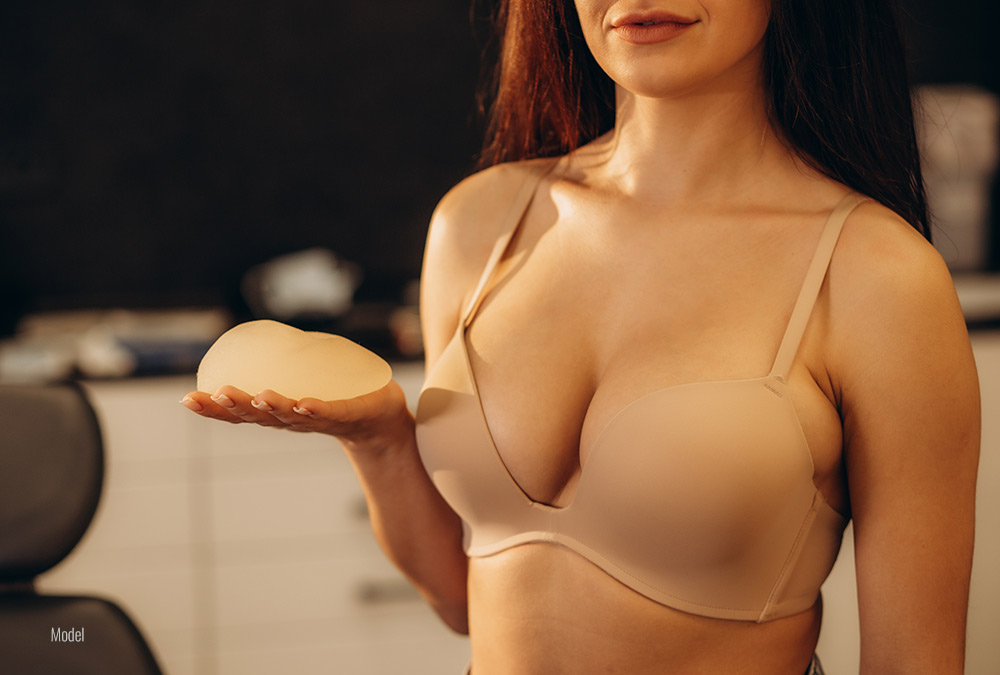Types of Implant Options for Breast Augmentation Surgery
Posted July 24, 2024 in Breast Augmentation

Breast augmentation does more than increase the size of the breasts–from size, shape, and material type; breast implants can completely change the look of the patient’s body. This blog discusses the various implant options that patients can choose from.
5 Min Read:
Which Type of Breast Implant Is Best?
Prized for its ability to deliver sexy curves, breast augmentation is a cosmetic procedure designed to increase the size of a woman’s breasts using breast implants. However, there is more to it than just increasing size: breast augmentation can also improve asymmetrical breasts, reshape the breasts, and alter their placement and projection from the chest.
Much of this versatility is due to the shape, form, and material of the breast implants used. Below, we will discuss the most common breast implant types and how they may affect the surgical result.
Saline Breast Implants
Saline breast implants are FDA-approved for patients as young as 18 years old. They consist of a silicone outer shell that does not come pre-filled from the manufacturer. This is often beneficial to patients who want as small an incision as possible, as the surgeon can insert the unfilled implant shell and then fill it with the saline solution afterward.
The saline (saltwater) solution is sterile and easily absorbed by the body in the event of an implant rupture–making this option lower risk than silicone. Saline implants are also usually less expensive than silicone, but they may not look or feel as natural. This type of implant, while easily customizable in size as it can be filled perioperatively, may be a good option for the patient who is more concerned about visible scarring than a natural look and feel.
Saline Breast Implant Pros:
- FDA-approved for younger patients
- More cost-efficient
- Less risk if a rupture occurs
- Smaller incision (less chance of visible scarring on the breast)
- More incision options (periareolar, inframammary, transaxillary, transumbilical)
Saline Breast Implant Cons:
- Higher chance of implants shifting and visible rippling
- Feels, moves, and looks less like natural breast tissue
Silicone Implants
Silicone implants are FDA-approved for patients over 22 years old and are made of a silicone shell that comes pre-filled with a silicone gel. Although they come pre-filled from the manufacturer, silicone implants come in a variety of shapes and sizes, making them just as customizable as saline. Additionally, silicone implants are regarded as the closest approximate to natural breast tissue: they move, feel, and look more like real breasts than saline. Part of this has to do with their more cohesive gel consistency, which holds its shape better than saline.
Patients also have the option of “gummy bear” or cohesive silicone implants, which are the newest type of implant on the market. These hold their shape even when pierced or cut, meaning there is less risk of leaking if or when a rupture occurs.
Silicone implants are very popular with patients who prioritize a natural look and feel to their implants, even in larger sizes, which is why most patients are fine spending a little more on their implants. There are a few drawbacks of this type, however, including the increased risk of adverse symptoms when a rupture occurs. It can also be difficult to tell if a silicone implant has ruptured, which is called a silent rupture, so physicians often recommend patients have routine MRIs or ultrasounds to ensure their implants’ continued viability. Lastly, silicone implants are restricted to a larger incision, usually along the bottom half of the breast, as they are pre-filled and less flexible than saline.
Silicone Implant Pros:
- Looks and feels like natural breast tissue
- Softer than saline, with natural-looking movement
- Wide range of sizes, shapes, and projection
- Gummy bear types have a lower risk of leaks
Silicone Implant Cons:
- More expensive than saline
- Higher risk of silent rupture
- A larger incision is necessary
Other Breast Implant Options to Consider
If you’re considering breast augmentation, breast implant type is only one of many factors to consider. Patients also need to think about how they want their breasts to look on their chest: how high they are, how much cleavage they want, how full their breasts are at the top, etc.
Your board-certified plastic surgeon will help you decide on the following options.
Round vs. Anatomical
Both silicone and saline breast implants have the option of being either round in shape or anatomical, which is like a teardrop shape. Anatomical breast implants are full at the bottom and come to a slope at the top, just like real breasts. Round implants are more circular, with equal fullness on the top and the bottom, resulting in a more dramatic, plump result.
Implant Placement
- Subglandular Placement (Above the muscle) puts the implants under the breast (glandular) tissue but over the pectoral muscles and can help improve mild breast ptosis (sagging).
- Submuscular Placement (Below the muscle) places the implants under the breast tissue and pectoral muscles. This may create a more natural breast appearance.
Interested in Breast Augmentation in New York, NY?
You don’t have to make these decisions alone–our experienced board-certified plastic surgeon, Dr. Eric Cha will walk you through each option and help you decide the best combination of options for you and your body. Call Fifth Ave Plastic Surgery today at (212) 717-2222 or fill out our online contact form to get started.